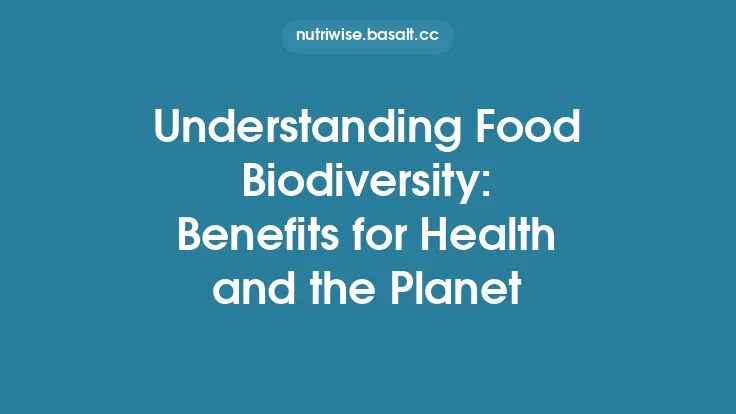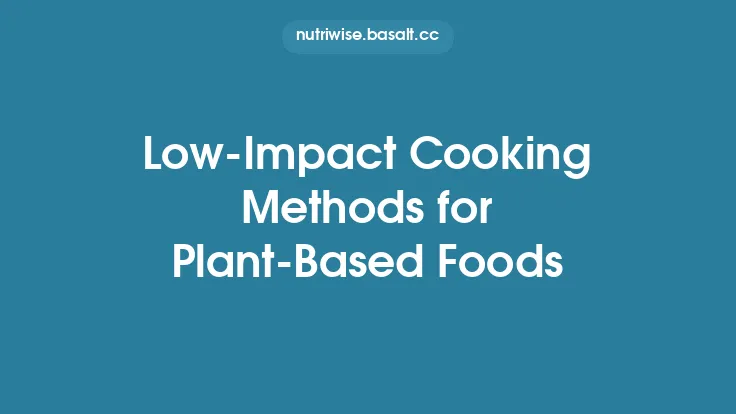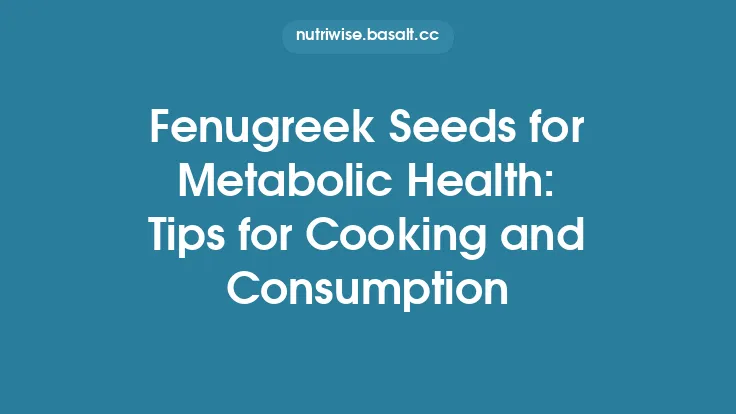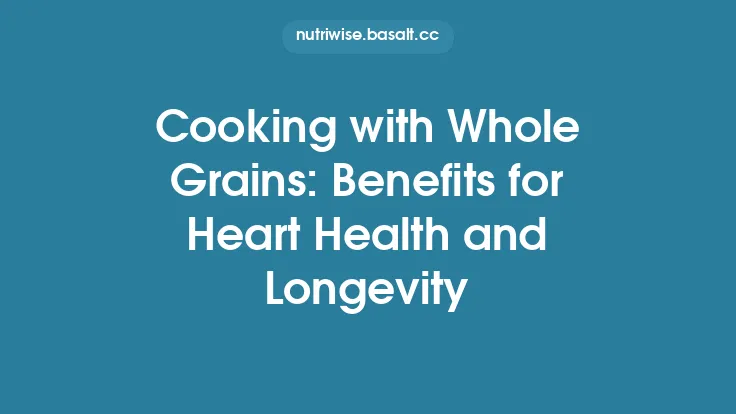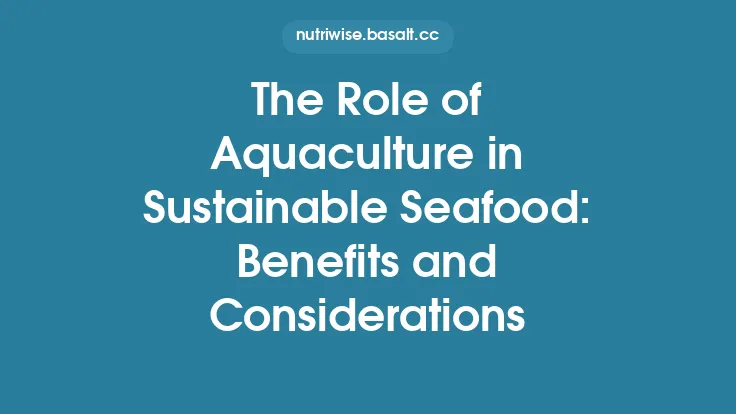Seafood is celebrated for its lean protein, essential omega‑3 fatty acids, and a range of micronutrients that support heart, brain, and overall health. Yet the way we bring fish and shellfish to the table can either amplify or diminish those benefits—both for our bodies and for the planet. While choosing responsibly sourced seafood is a crucial first step, the cooking process itself plays a pivotal role in determining the environmental footprint of a meal. By selecting low‑impact cooking techniques, we can preserve the delicate nutrients of the catch, reduce energy consumption, limit the formation of harmful compounds, and minimize kitchen waste. Below is a comprehensive guide to cooking seafood in ways that are gentle on the environment, kind to our health, and still deliver delicious, satisfying dishes.
Why Cooking Method Matters for Sustainability
- Energy Use
- High‑heat methods such as deep‑frying or prolonged oven roasting demand significant electricity or gas, contributing to greenhouse‑gas emissions, especially when the energy source is fossil‑fuel based.
- Low‑temperature, short‑duration techniques (e.g., steaming, poaching, sous‑vide) often require less energy overall, especially when paired with efficient appliances.
- Nutrient Retention
- Overcooking fish can degrade heat‑sensitive omega‑3 fatty acids (EPA and DHA) and water‑soluble vitamins (B‑complex, vitamin C).
- Gentle cooking preserves these nutrients, meaning you get more health benefit from the same amount of seafood, reducing the need for larger portions.
- Formation of Harmful Compounds
- High‑temperature dry‑heat methods can generate heterocyclic amines (HCAs) and polycyclic aromatic hydrocarbons (PAHs), both linked to increased cancer risk.
- Moist‑heat methods and lower temperature cooking dramatically cut the formation of these compounds.
- Water and Waste Management
- Techniques that reuse cooking liquids (e.g., broth from poaching) or incorporate shells and heads into stocks keep valuable nutrients in the food system and reduce kitchen waste.
Understanding these connections helps us choose cooking methods that align with both personal health goals and broader sustainability objectives.
Energy‑Efficient Techniques
| Technique | How It Works | Energy Profile | Ideal Seafood Types |
|---|---|---|---|
| Steaming | Food sits above boiling water, cooked by steam’s latent heat. | Low to moderate; uses only the water’s heat once boiling is reached. | Fillets, whole white fish, mussels, clams. |
| Poaching | Seafood gently simmers in a flavored liquid (water, broth, wine). | Low; the liquid stays just below a boil, requiring less sustained heat. | Delicate fish (cod, sole), shrimp, scallops. |
| Sous‑Vide | Vacuum‑sealed packets cooked in a water bath at precise, low temperatures (45‑65 °C). | Very efficient when using a circulator with good insulation; heat is evenly distributed, reducing cooking time. | Salmon, tuna steaks, lobster tails. |
| Microwave Steaming | Food placed in a microwave‑safe container with a small amount of water; steam cooks the seafood. | Extremely low; microwaves directly heat water molecules, cutting energy use dramatically. | Small fillets, fish sticks, shellfish. |
| Induction‑Based Sear‑Then‑Finish | Quick high‑heat sear on an induction stove, then finish in a low‑heat oven or sous‑vide bath. | The initial sear is brief, and induction is highly efficient; overall energy use stays low. | Thick‑cut salmon, swordfish steaks. |
Practical tip: When using a stovetop, match the pot size to the burner. A small pot on a large burner wastes heat. Covering the pot traps steam, reducing cooking time and energy consumption.
Moist‑Heat Methods that Preserve Nutrients
1. Steaming with Aromatics
- Process: Add sliced ginger, lemongrass, or herbs to the water. The steam infuses subtle flavors without extra fat.
- Nutrient benefit: Omega‑3s remain intact because the fish never contacts water directly, and water‑soluble vitamins are not leached out.
- Environmental edge: No oil is required, and the water can be reused for tea or plant watering after cooling.
2. Poaching in Light Broths
- Process: Combine low‑sodium fish stock, white wine, citrus slices, and a pinch of sea salt. Keep the liquid just below a simmer (≈80 °C).
- Nutrient benefit: The gentle temperature prevents protein denaturation that can cause moisture loss, keeping the flesh tender and juicy.
- Environmental edge: The poaching liquid becomes a flavorful base for soups or sauces, eliminating waste.
3. Sous‑Vide Precision Cooking
- Process: Seal a seasoned fillet in a vacuum bag with a splash of olive oil or a dab of butter. Set the circulator to the target internal temperature (e.g., 52 °C for salmon).
- Nutrient benefit: The sealed environment locks in omega‑3s and prevents oxidation. The low, constant temperature avoids the formation of HCAs/PAHs.
- Environmental edge: Because the water bath is insulated, only a modest amount of energy is needed to maintain temperature. Batch‑cook multiple portions in one bath to maximize efficiency.
4. Low‑Temperature Oven Baking (Gentle Roast)
- Process: Preheat the oven to 120‑150 °C, place fish on a parchment‑lined tray, and bake until the internal temperature reaches 55 °C.
- Nutrient benefit: Slow baking preserves moisture and reduces the need for added fats.
- Environmental edge: Modern convection ovens circulate hot air efficiently, cutting cooking time compared to conventional ovens.
Dry‑Heat Methods with Minimal Emissions
1. Pan‑Searing with a Thin Oil Film
- Technique: Use a well‑seasoned cast‑iron or stainless‑steel skillet, add just enough high‑smoke‑point oil (e.g., refined avocado oil) to coat the surface, and sear quickly (1‑2 minutes per side).
- Why it’s low‑impact: The brief high heat limits overall energy use, and a thin oil layer reduces the amount of oil that must be produced, transported, and disposed of.
- Health note: Quick searing locks in flavor while keeping the interior moist, preserving omega‑3s.
2. Grilling on a Pre‑heated Grill Pan (Indoor)
- Technique: Heat a grill pan on an induction or electric stovetop, then place the fish directly on the ridges. The contact area is small, so the cooking time is short.
- Why it’s low‑impact: No charcoal or propane is needed, eliminating combustion emissions. The pan’s metal conducts heat efficiently, using less electricity than a full‑size grill.
- Flavor tip: Add a splash of citrus or a brush of herb‑infused oil after grilling to enhance taste without extra smoke.
3. Broiling with a Controlled Distance
- Technique: Position the fish 6‑8 cm below the broiler element, using a foil‑lined tray to catch drippings. Broil for 3‑5 minutes, flipping once.
- Why it’s low‑impact: The broiler’s radiant heat cooks quickly, using only a fraction of the oven’s total energy.
- Safety note: Keep the broiler clean to avoid flare‑ups that produce PAHs.
Low‑Impact Preparation and Waste Reduction
- Whole‑Fish Utilization
- Head & Bones: Simmer to create a nutrient‑dense stock that can serve as a base for soups, risottos, or sauces.
- Skin: Crisp in a hot, dry pan for a crunchy garnish; the skin contains additional omega‑3s and collagen.
- Scales & Trimmings: Dry‑roast and grind into a fine powder for use as a natural umami seasoning.
- Portion‑Control & Batch Cooking
- Cook exact portions to avoid leftovers that may be discarded. If leftovers occur, repurpose them into salads, tacos, or fish cakes, reducing food waste.
- Water Conservation
- Reuse steaming water (once cooled) to water indoor plants or for cleaning purposes.
- When poaching, use the same liquid for multiple batches, adding fresh aromatics each time.
- Eco‑Friendly Cookware Choices
- Cast Iron & Stainless Steel: Durable, recyclable, and retain heat efficiently, lowering energy demand over time.
- Ceramic Non‑Stick: Free of PTFE/PFOA, offering a low‑oil cooking surface without chemical concerns.
- Avoid disposable aluminum foil or single‑use parchment when possible; instead, use reusable silicone mats or reusable parchment.
- Composting Shells & Bones
- Crushed shells (especially from oysters, clams, and mussels) are rich in calcium and can be added to compost piles, improving soil health for home gardens.
Integrating Plant‑Based Sides for a Balanced Plate
A low‑impact seafood meal is not just about the fish; the accompaniments can amplify sustainability:
- Seasonal Vegetables: Choose locally grown, in‑season produce to minimize transportation emissions.
- Whole Grains: Quinoa, farro, or brown rice provide fiber and complement the protein without adding significant carbon load.
- Legume‑Based Salads: Chickpeas or lentils add plant protein, reducing the overall demand for animal‑derived foods.
- Herb‑Forward Sauces: Chimichurri, salsa verde, or a simple lemon‑herb vinaigrette add flavor without heavy cream or butter, keeping the dish light and environmentally friendly.
By pairing seafood with plant‑forward sides, you create a nutritionally complete meal while further lowering the overall ecological footprint.
Practical Tips for Home Cooks
| Goal | Action | Expected Impact |
|---|---|---|
| Cut Energy Use | Cook multiple portions in one batch (e.g., sous‑vide a tray of fillets). | Reduces total heating cycles. |
| Preserve Omega‑3s | Use gentle temperatures (≤65 °C) and avoid prolonged high heat. | Maintains fatty‑acid integrity. |
| Minimize Harmful Compounds | Limit direct flame contact; opt for steaming or poaching. | Lowers HCAs/PAHs formation. |
| Reduce Waste | Save shells and heads for stock; compost vegetable trimmings. | Keeps nutrients in the food system. |
| Choose Efficient Cookware | Use induction-compatible pans; keep lids on pots. | Improves heat transfer, cuts cooking time. |
| Flavor Without Fat | Use citrus zest, fresh herbs, aromatics, and spices. | Enhances taste while keeping the dish light. |
| Water Management | Reuse poaching liquid; collect steam condensate for plants. | Conserves water resources. |
Conclusion: A Holistic Approach
Low‑impact seafood cooking is a convergence of three core principles: energy efficiency, nutrient preservation, and waste minimization. By selecting methods such as steaming, poaching, sous‑vide, and brief high‑heat sears, we keep the environmental cost of each meal low while delivering the full health benefits that seafood offers. Pairing these techniques with thoughtful preparation—using whole fish, repurposing scraps, and integrating plant‑based sides—creates a dining experience that honors both personal well‑being and planetary stewardship.
Adopting these practices doesn’t require a complete kitchen overhaul; incremental changes—like swapping a deep‑fry for a quick steam, or reusing a poaching broth for a soup—can add up to substantial reductions in carbon emissions, water use, and food waste over time. As we continue to refine our cooking habits, we contribute to a more resilient food system where the ocean’s bounty can be enjoyed today and preserved for future generations.
